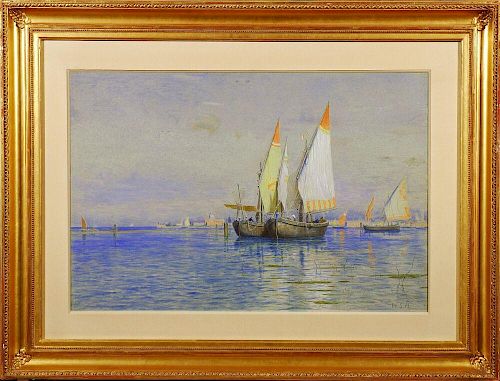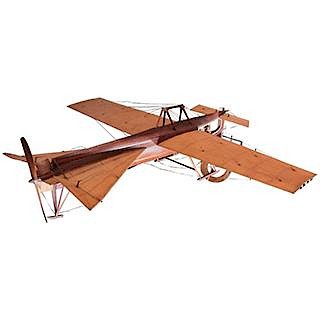William Stanley Haseltine (1835-1900), Fishing Boats, Venice
About Auction
Mar 16, 2017 - Mar 30, 2017
Bidsquare info@bidsquare.com
- Lot Description
For more information, email: gallery@hirschlandadler.comFishing Boats, VeniceWatercolor and gouache over graphite on blue paper, 16 x 22 in.Signed with initials (at lower right): W.S.H.Painted between 1871 and 1885EXHIBITED: Hirschl & Adler Galleries, New York, 1992, William Stanley Haseltine (1835-1900) and Herbert Haseltine (1877-1962), pp. 7, 18 illus. in color, 20 no. 20EX COLL.: Mr. and Mrs. John Pierpont Morgan, London, England; private collection, until 1991Fishing Boats, Venice recalls a time, a place, and a social circle that lived for a charmed moment and a favored few in nineteenth-century Europe. William Stanley Haseltine was an American expatriate artist who made his home and studio “into a permanent meeting ground for the many distinguished foreigners, Americans and English, who came to Rome. . . .” (Helen Haseltine Plowden, William Stanley Haseltine, Sea and Landscape Painter (1835-1900): Notes and Recollections From His Life [1947], p. 97). Among these were Louisa Crawford Ward (daughter of New York banker and art patron Samuel Ward, sister of Julia Ward Howe, and widow of American sculptor Thomas Crawford); Henry Wadsworth Longfellow; Frederick Crowninshield (Boston Brahmin poet and painter); artist Edward Darley Boit; lawyer Joseph Choate; historian George Bancroft; writer Charles Francis Adams; and financier Junius Spencer Morgan, father of John Pierrepont Morgan, the original owner of this work. From 1874 until the artist's death, the family lived in the Palazzo Altieri, a sixteenth-century residence built by Cardinal Gian Battista Altieri Seniore and his uncle Pope Clement X. The Haseltines gathered together under their splendid and commodious roof an international literary, cultural, and artistic salon with a distinctly American accent.The career of William Stanley Haseltine spans the entire second half of the nineteenth century. During these years he witnessed the growth and decline of American landscape painting, the new concept of plein-air painting practiced by the Barbizon artists, and the revolutionary techniques of the French Impressionists, all of which had profound effects on the development of painting in the western world. Haseltine remained open to these new developments, selecting aspects of each and assimilating them into his work. What remained constant was his love of nature and his skill at rendering exactly what he saw. His views, at once precise and poetic, are, in effect, portraits of the many places he visited and the landscapes he loved.Haseltine was born in Philadelphia, the son of a prosperous businessman. In 1850, at the age of fifteen, he began studying with Paul Weber, a German artist who had settled in Philadelphia two years earlier. From Weber, Haseltine learned about Romanticism and the meticulous draftsmanship that characterized the German School. At the same time, Haseltine enrolled at the University of Pennsylvania, and took sketching trips around the Pennsylvania countryside, exploring areas along the Delaware and Susquehanna rivers. Following his sophomore year, Haseltine transferred to Harvard University.After graduating from Harvard in 1854, Haseltine returned to Philadelphia and resumed his studies with Weber. Although Weber encouraged Haseltine to continue his training in Europe, the elder Haseltine was reluctant to encourage his son to pursue a career as an artist. During the next year, Haseltine took various sketching trips along the Hudson River and produced a number of pictures, some of which were exhibited at the Pennsylvania Academy of the Fine Arts in the spring of 1855. Ultimately, having convinced his father that he should be allowed to study in Europe, Haseltine accompanied Weber to Düsseldorf.The Düsseldorf Academy was, during the 1850s, at the peak of its popularity among American artists. The Academy’s strict course of study emphasized the importance of accurate draftsmanship and a strong sense of professionalism. Landscape painting was the dominant department at the Düsseldorf Academy during this period, and the most famous landscape painter there was Andreas Achenbach, under whom Haseltine studied. Achenbach’s realistic style stressed close observation of form and detail, and reinforced much of what Haseltine had already learned. His Düsseldorf training remained an important influence on him for the rest of his life.At Düsseldorf, Haseltine became friendly with other American artists studying there, especially Emanuel Leutze, Worthington Whittredge, and Albert Bierstadt. They were constant companions, and in the spring and summer months took sketching trips together. In the summer of 1856 the group took a tour of the Rhine, Ahr, and Nahe valleys, continuing through the Swiss alps and over the Saint Gotthard Pass into northern Italy. The following summer Haseltine, Whittredge, and the painter John Irving returned to Switzerland and Italy, and this time continued on to Rome.Rome was a fertile ground for artists at mid-century. Virtually every major artist went there at some point, and some set up permanent homes and studios. When Haseltine arrived in the fall of 1857, the American sculptors Harriet Hosmer, Chauncey B. Ives, Joseph Mozier, William Henry Rinehart, and William Wetmore Story had flourishing studios. The poets, Robert and Elizabeth Barrett Browning, were in residence, and Nathaniel Hawthorne was at work on The Marble Faun. Like his fellow landscape painters, Haseltine was drawn to the Roman Campagna, where he executed numerous sketches of the ruins and the surrounding countryside. He also traveled south to Amalfi, Sorrento, and Capri.After a two-year stay in Rome, Haseltine returned to America. He first set up a studio in Philadelphia, but by the fall of 1859 had moved to the Tenth Street Studio Building in New York, where Whittredge and Leutze were also located. Haseltine was active in the social and artistic life of the Tenth Street Studio Building, participating in studio receptions and receiving favorable, sometimes glowing, reviews of his work. He exhibited annually at the National Academy of Design, where he was elected an associate in 1860, and a full academician in 1861. His work was also included in the annual exhibitions at the Pennsylvania Academy of the Fine Arts and the Boston Athenaeum. Initially, Haseltine showed works based on his European sketches. Then, as he accumulated sketches from trips along the Delaware and the coasts of New Hampshire, Maine, Rhode Island, and Massachusetts, he began to send paintings of American subjects to the exhibitions.Haseltine spent the summer of 1862 sketching along the New England coast, stopping along the way in Narragansett, Rhode Island. The rocky coast there must have made an enormous impression on him, for the following March he submitted three Narragansett paintings to the Brooklyn Art Association and two in April to the National Academy of Design. While his European and other American subjects continued to appear in exhibitions, his paintings of Rhode Island, what Henry Tuckerman termed his “rock-portraits” (Book of the Artists [1867], p. 557), were considered his greatest success. Haseltine’s concern for accurate geological detail reflected the pervasive influence of the Pre-Raphaelite movement during these years. Indeed, his luminist coastal views of the 1860s parallel the work of William Trost Richards, one of the most devoted practitioners of the Pre-Raphaelite style. Richards had also studied under Paul Weber in Philadelphia, and his landscapes exhibit a similar concern with meticulous detail and atmospheric effects.In 1860, Haseltine married Helen Lane. She died giving birth to their second child in 1864. In 1866, Haseltine married his late wife's best friend, Helen Marshall, the daughter of Captain Charles Henry Marshall, who had been a part owner of the Black Ball Steamship Line. In the spring of 1866, the family returned to Europe, where Haseltine set up a studio on the Boulevard de Clichy in Paris. Shortly thereafter he began traveling in search of subjects for his painting, spending time in Rome, Naples, Sicily, and Paris. By the fall of 1868, Haseltine was back in Rome, where he took a studio in the same building as Frederic Church and Jervis McEntee. Many other American artists were also in Rome at the time, including Sanford Robinson Gifford, whom Haseltine had met during his student years while travelling through Switzerland, and George P.A. Healy, who painted the Haseltines’ portraits. In the spring of 1869 Haseltine traveled to the United States with his eldest son, Stanley, but returned to Europe where the family settled permanently in Rome.The Haseltine home, first in the Palazzo Carcano, then in the Palazzo Altieri, then became a popular meeting place for an international group of artists, writers, diplomats, and other notables, a social and cultural milieu of wealth, talent and intellect. As Haseltine’s fame grew, orders for pictures flowed in from influential patrons around the world, including J.P. Morgan, John Cabot Lodge, the Duke of Nassau, and the King of Denmark, all of whom requested Italian views. Throughout the 1870s and 1880s, Haseltine traveled every summer throughout Europe or the United States in search of new material.In the late 1880s and 1890s the Haseltine family spent summers in Traunstein, Bavaria. Haseltine returned to America frequently during the 1890s, in 1893 to visit the World’s Columbian Exposition at Chicago and to enroll his son Herbert in school in Connecticut, and, later, to help Herbert settle in at Harvard. In 1899 father and son took a trip West, visiting California, Washington, Oregon, Alaska, Banff, and Yellowstone.When Haseltine returned to Rome that fall, he began work on a new painting, but it was never finished. He was struck with pneumonia just after the New Year, and he died within a few days. Obituary notices that listed his most famous works consistently mentioned his New England rock paintings and his Italian views, subjects for which he is still best known today.Beginning in 1871 and continuing throughout the 1880s, Haseltine customarily spent several weeks during the summer or autumn months in Venice, sketching the opal-colored skies, lagoons, architectural monuments, and fishing boats. In these outdoor views, reflecting the influence of plein-air painting, Haseltine achieved a synthesis of faithfully observed realism and a concern with the effects of sparkling light that he shared with the impressionists. (For the most thorough discussion of this period in Haseltine's life, including his work in watercolor, see Andrea Henderson's essay, "Haseltine in Rome," in The Fine Arts Museums of San Francisco, Expressions of Place: The Art of William Stanley Haseltine, exhib. cat. [1992], pp. 33-52.) Haseltine's views of Venice number among his best works. In the present example, Fishing Boats, Venice, the city shimmers in the background as Haseltine focuses his attention on the confluence of sky and water punctuated by the colorful fishing boats of the Venetian fleet. The day is calm and bright and the artist's initials at the lower right echo the Japanesque grace of the reeds that sway gently in the shallow lagoon waters.Haseltine's mastery of the watercolor medium is clearly evident in this work, and in two related works, Venice (11 3/4 x 18 1/2 in.; Columbus Museum of Art, Ohio), and Fishing Boats in Venice, 1881 (14 x 21 in.; Oklahoma Art Center, Oklahoma City). Fishing Boats, Venice also shares compositional elements with two oil paintings, both painted about 1875, Venice I (23 1/2 x 48 1/2 in.; The Detroit Institute of Arts, illus. in ibid., p. 130 no. 54) and Venice (32 1/2 x 58 1/2 in.; private collection, illus. in ibid., p. 131 no. 55).Haseltine didn't need to sell works in order to support his family, and, indeed, his wife, Helen Marshall Haseltine, had no enthusiasm for the kind of social and business obligations attendant to the families of expatriate artists in pursuit of "grand tour" commerce. As a result, the bulk of Haseltine's watercolor scenes remained in the family collection at the time of his death and were exhibited posthumously in April 1901 at the Palazzo Altieri (ibid., p. 49 fn. 56).William Stanley Haseltine’s peripatetic life gave him first-hand knowledge of the various artistic movements that developed in America and Europe between 1850, the year he began his training, and 1900, the year of his death. His art reflected his independence: he never aligned himself with any school, nor did he limit himself to a particular dogma. He had a Luminist’s sense of light and atmosphere, a Pre-Raphaelite’s fascination with natural detail, a Romantic’s love of scenic landscapes, and an Impressionist's understanding of light and color. With skill and insight, he was able to capture the essence of a place, wherever he was. Whether in the clear, sparkling light of the New England coast, the cool haziness of the Low Countries, or the brilliant sun of the Mediterranean, Haseltine created exacting, yet expressive portraits of nature in the Old World and the New.APG 7722 MEW/AKN WSH7722 C
- Shipping Info
-
STORAGE AND SHIPPING INFORMATION
As the Buyer, you are responsible for the pick-up or shipment of the property you have purchased.
As a courtesy, the Seller has made arrangements with a variety of third party shippers to provide shipping quotes for Buyers. Please note that shipping remains the responsibility of the Buyer, and we highly recommend getting quotes during any preview period for large, fragile or heavy items so you can consider the shipping costs before bidding. As set forth more fully in the Terms of Sale, under no circumstances will the Seller or Bidsquare be held responsible for items entrusted to a third party shipper.
Shipping small items by common carrier (UPS, FedEx, DHL or USPS): Each of the Sellers has engaged shippers to pick up several times a week. Once the Seller receives your payment and the completed shipping form authorizing the release of your property to the shipper, the Seller will add your lot(s) to the list for the next pick up. Shipping quotes will be included in the invoice.
Shipping larger items by freight (for example: furniture, bulky or odd shaped items): For items that exceed allowable dimensions or weight restrictions of UPS, Fed Ex and similar carriers, the Seller may provide assistance in arranging for delivery by freight. Please keep in mind that delivery of these types of items can be an expensive proposition, so you should consider this before bidding. Please remember that it is your responsibility to pay for all deliveries.
Pick up: Please check the Seller’s pick up policies and be sure to bring your own packing materials.
Removal of Property:. Regardless of whether you arrange to have your property shipped or picked up, all property must be paid for and removed from the Seller within 14 days of the auction. Storage fees are charged beginning on day 15. For more details see below and see our Terms of Sale. Neither the Seller nor Bidsquare is responsible for any damage or loss of property purchased but not removed from the Seller within 14 days of the auction. Starting on day 15 following the acution, the Seller may, at its sole discretion, remove the purchased Property to public storage at the Buyer’s risk and expense. All associated charges will be added to the total or subsequent invoice and must be paid in full before the Property will be released.
Property purchased and left at the Seller for 90 days or longer will be sold or donated for you, at the Seller’s sole discretion.
Frequently Asked Questions
May I use one check to pay for the invoice and shipping charges?
Yes. You will receive a combined invoice for the item that includes shipping charges.Will I be charged tax for picking up the item at the Seller?
An 8.875% New York sales tax will be added to your invoice if you pick up your property from the Seller. This tax will be waived if you have a resale number. You must complete the proper documentation in order to avoid the sales tax charge.Do I need to pay for insurance coverage for the items in shipment?
We highly recommend insuring your items for their full value during shipping. If you choose to waive the insurance coverage, we require a signed waiver from you stating that you accept full liability for any damage that may occur in shipment.What happens if my item is damaged during shipment?
It is a rare occurrence, but if your item arrives damaged, you must keep all packaging materials. Notify the Seller immediately. Take photographs of the damage to the box as well as the item. A representative from the shipping company will make an appointment to come and inspect the damage and begin the claim process.
-
- Buyer's Premium



 EUR
EUR CAD
CAD AUD
AUD GBP
GBP MXN
MXN HKD
HKD CNY
CNY MYR
MYR SEK
SEK SGD
SGD CHF
CHF THB
THB











